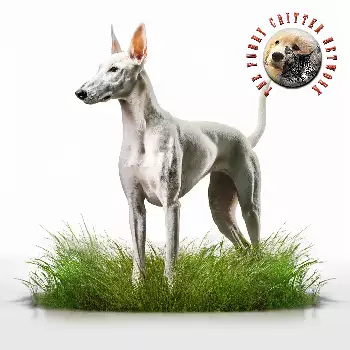The Ibizan Hound presents a striking and unmistakable silhouette characterized by elegance, athleticism, and distinctive features. This medium to large sighthound stands between 22.5 to 26 inches at the shoulder for females and 23.5 to 27.5 inches for males, with a weight range of approximately 45 pounds for females and 50 pounds for males. The breed's overall appearance conveys an impression of deer-like grace combined with remarkable power and agility, with every aspect of its structure designed for speed, endurance, and remarkable jumping ability.
The head is long and narrow with a flat skull that is longer than the muzzle. The most distinctive feature is the large, erect ears that are mobile and highly expressive, pointing upward when the dog is alert and carried naturally at other times. These prominent ears are broad at the base, pointed at the tip, and are never allowed to droop. The eyes are amber or clear in color, oblique in shape, and express intelligence and alertness. The eye color should harmonize with the coat color. The nose is flesh-colored, and the muzzle is long and narrow with tight lips.
The neck is long, slender, slightly arched, and strongly muscled, blending smoothly into well-laid-back shoulders. The body shows a level topline that slopes slightly from the prominent hip bones to the tail. The chest is deep and narrow with a pronounced forechest and well-sprung ribs that provide lung capacity without excessive width. The underline shows a distinct tuck-up creating an elegant profile. The back is level and strong, with a long, sloping croup. The Ibizan Hound's narrow body and exceptional flexibility contribute to its remarkable jumping ability, as the breed can leap impressive heights from a standstill.
The forequarters feature long, flat, strong shoulder blades that are well laid back, with straight front legs that are long, strong, and set well under the body. Pasterns are strong, flexible, and slightly sloping. The feet are hare-like, with long toes, thick pads, and strong nails. The hindquarters are powerful with long, strong thighs, well-bent stifles, and well-let-down hocks. The tail is set low, reaching at least to the hock, and is carried in a variety of positions from a sickle curve to straight down depending on the dog's mood and activity level.
The coat comes in two varieties: smooth and wire-haired. The smooth coat is short and dense, while the wire-haired variety has hair that is one to three inches in length, harsh in texture. Both coat types may have longer hair on the back of the thighs and the underside of the tail. Acceptable colors include white, red (ranging from light to deep red), or any combination of red and white. No color preference exists, and solid white, solid red, or white with red markings are all equally acceptable. The red color can range from a light yellowish-red to a deep rich red. The pigment on nose, eye rims, and pads should be harmonious with coat color.
Sexual dimorphism is evident in the breed, with males appearing more substantial and powerful while females are slightly smaller and more refined in appearance. Both sexes should display the breed's characteristic elegance and balance. The breed's movement is efficient, far-reaching, and seemingly effortless, with a suspended trot that appears to float above the ground. When galloping, the Ibizan Hound displays remarkable speed and the ability to change direction quickly, characteristics essential for hunting over rough terrain. Serious faults include any deviation from the breed's distinctive type, including upright shoulders, straight stifles, coarse heads, or improper ear carriage.
Affection Level
★
★
★
★
★
Affectionate with family members but reserved with strangers
Good with Children
Generally good with older children who respect their space; may be too energetic for toddlers
Good with Other Dogs
★
★
★
★
★
Usually friendly with other dogs when properly socialized
Good with Other Pets
Moderate to low due to high prey drive; may chase cats and small animals
Playfulness
Very playful and energetic, especially when young
Energy Level
High energy requiring substantial daily exercise
Trainability
Moderately trainable; independent nature requires patient, positive methods
Intelligence
Highly intelligent but thinks independently; problem solver
Tendency to Bark
Moderate; will bark to alert but not excessively vocal
Amount of Shedding
Low to moderate shedding; manageable with regular brushing
Grooming Needs
Low maintenance; weekly brushing sufficient for most
Prey Drive
Very high; bred to hunt and will chase small animals instinctively

